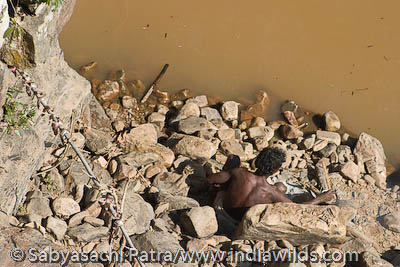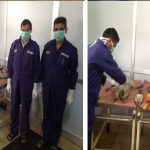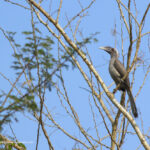Sunabeda – Tiger Census
January 2006
I woke up abruptly, on the incessant barking of the dogs. I fumbled across the bed for my watch; it was five in the morning and about an hour before dawn. The dogs were persistent in their barking. It was not the usual barking that we city dwellers are used to; fear was evident from their voice. I tiptoed out of the bed to open the door. The dog within the forest rest house compound wall was shivering with fear. It was dark outside. We had reached late in the night – as the headlights of our vehicle was not working and we had to use the torch light to illuminate the road and reach the forest rest house – so I didn’t have much idea about the nearby village. To make matters worse, now I couldn’t find the torchlight. I thought it would have been foolhardy to venture out in dark in search of a possible leopard without a faintest idea of the layout of the place. The sound of dogs from several places made me realise that there could be a large human settlement around the forest rest house.
On sunrise I was shocked to find myself in the midst of a large village with Dish TVs and broccoli cultivation. This was my first visit to the Sunabeda Sanctuary and before the Tiger census could start I must admit that I was pretty disappointed.
A quick cold bath and breakfast later I was ready. But alas, it was not before eight that the forester arrived, despite assurances to the contrary made the previous night. Later on in the day after my repeated questioning, the truth came to light. I was told that nobody from the forest department wakes up in the morning. And if it is going to be a long day in the jungle, then they will eat their lunch in the morning and start their day. You will realize that they are like scores of other people who are unfortunately in the wrong job, meagerly paid and ill-at-ease with a physically challenging job. The high average age of the staff – some of them are near retirement agae – doesn’t help matters either.
We drove down to Datunama village – a hamlet consisting of seven huts, about twelve kilometers from Sunabeda, picked up a tribal youth and started our march. This village is inhabited by paharias who are officially categorized as OBC in Orissa, but are recognized as Scheduled Tribe in the neighbouring state of Chhatisgarh. These people heavily depend on the forest produce like bamboo, fish etc. They don’t know the use of fishing nets yet. To catch fish, the paharia’s use mud and the poison extracted from some wild fruits to muddy the small pools. The fish then die due to want of oxygen and float in the surface. The paharia’s then catch these fish and dry them in the sun.

Paharia tribe in Sunabeda Sanctuary, Orissa

Sunabeda Sanctuary, Orissa
The paharias also extract honey from honeycombs which are mostly located in the steep cliffs. The paharias climb to the top of the cliff from the other side and then lower themselves using either a vine or a ladder. They use smoke to ward off the honeybees. This results in white patches on the cliffs. A casual observer can easily mistake these signs for Vulture droppings. Unfortunately this kind of disturbance is driving away the vultures from prime nesting sites. Though law prohibits commercial extraction of bamboo products, honey and other forest produce, the paharia’s are doing it unchecked due to lack of effective patrolling, inefficiency and at most of the times by the involvement of the forest staff. There were signs of irreparable damages to the jungle and wildlife wrought upon by the paharias.
I had selected a route in the forests criss crossing the Orissa-Chhatisgarh border several times. We crossed several hills, locally known as dongar, scanned the valleys for possible pugmarks. I was very happy when I saw some of the natural water holes created in the hills, ideal place for a tiger to rest in the rock crevices with plenty of water flowing from the perennial streams. The route we had selected was very tough, comprising mostly of game trails. At one point I had to pack my camera in the bag and use all my hands and feet to climb down a steep precipice. We reached a place known as bhima basa by the local paharias. There was a huge waterfall about 56 meters high, which had been reduced to a trickle due to the offseason and the nullah bed was mostly dry.
Walking in the nullah bed was a learning experience as far as the hunting techniques of the paharia’s are concerned. I saw several stones raised and supported by sticks. Immediately Archimedes came to my mind. However, realizing that the paharias are not scientifically inclined I checked with our local guide. I was told that when a mouse deer enters the hole at the bottom of the raised stone, the stick falls and the poor animal is crushed to death.
After walking for several hours on the dry nullah bed, searching for signs of the apex predator, I came across a slight clearing. A small pool had formed in the nullah bed, and human footprints were clearly imprinted in the soft sand. I was really curious to findout what brought someone to this remote corner of the Sunabeda sanctuary, where the jungle is so dense that little light filters through the canopy. On following the footsteps, I found a large area under ganja cultivation (Cannabis sativa indica). The Cannabis plants had already flowered and were just a few days away from harvesting.
.jpg)
Ganja cultivation in Sunabeda, Orissa
.jpg)
Ganja plant in Sunabeda, Orissa
Carefull cross-questioning of the locals, forest staff and other people, revealed that the paharias mostly undertake these Ganja or marijuana or Cannabis sativa indica cultivation at the behest of the drug lords. A lot of drug money is now flowing into the Sanctuary. And a lot of extraneous pressure is being applied on the forest officials. There were reports of the people being incited by interested parties against any forest official who resists their evil designs. One of the rangers was manhandled by these people and a false case slapped against him. I sincerely doubt if any individual forest officer can withstand the temptation of money and the muscle power of drug lords.
Those few places, which could have been the last refuge of the Tiger, are being overtaken by the drug mafia. Money power and other evil influences of our so called civilized world have already corrupted the once innocent tribals. We found Dish TVs in most of the villages inside the sanctuary. I was told that pornographic movies are freely available and recently there have been cases of rape. These bitter truths forced me to change the image that I had in my mind of tribals as innocent people. These people who are staying in the sanctuary, having tasted the scent of narcotics money, can easily convince our well meaning tribal welfare activists into believing that people should co-exist with the tiger.
After couple of hours, we came across a hamlet known as Thalipani which is inhabited by a tribe known as Bhunjia. This hamlet is in an encroached area like many others in the sanctuary. There are many NGOs who are working with them to teach them cultivation, handicraft and other skills and unfortunately they work at crosspurposes with the forest department and wildlife. From this village, I came to know that a tiger had roared a day before in the hill “dongar” infront of the village. I was amazed to find that about 4-5 square kilometers area is cleared by this hamlet which houses about seven to eight people. This tale is repeated at every hamlet. Near all these hamlets I found the pugmarks, scats and scratch marks of leopards but not tigers. It is clearly evident that, with increased human activity the Tiger is retreating and the Leopard is taking its place.
When I was on my way to Kanwaldhara waterfall, suddenly I froze in my tracks. It was the unmistakable sound of a gunshot. At that time I was inspecting a three feet wide drag mark going downhill. There were signs of cooking nearby. My worst suspicion that poaching is a reality was confirmed. In the evening while returning to the camp, I saw two spotted deer, grazing on the left side of the road virtually vanish within a blink of an eye. I had never seen a more alarmed cheetal in my life. Upon detailed cross questioning I was told that poaching does take place in the Sanctuary.
With half of the sanctioned posts remaining vacant and the average age of the other half in the late forties, coupled with demotivation due to a variety of reasons including poor salary, I certainly can’t pin all the blame on the forest department. Neither can you absolve them of all sins when you find trees cut down and only the choicest wooden planks taken away and the rest left to rot. Your blood tends to boil when you realize that you are the only one against an entire system. With a heavy heart you lie down to sleep, hoping for a miracle to happen, to see some jungles which is not yet molested by the never ending greed of man – to find some inviolate spaces where the wildlife can roam, dreaming of seeing the early morning rays glistening on the striped coat of God’s most beautiful creation…
The search for the tiger took me to Chaura Dongar and then to Dudhpani plateau. I found scats of sloth bear, scrapping of leopard and hoof marks of herbivores. While searching for wild buffalows I was amazed to find cowdung at an altitude of 812 meteres. I moved in that direction and found a cattle pen constructued by the Gujjars. They had left the area sometime back. The Gujjar’s come from Chattisgarh and leave their cattle to graze in the meadows, benefiting from the lack of patrolling by the forest department. It is difficult for the herbivores to withstand such biotic pressures from the domestic cattle. Furthermore, there are chances of the dreaded foot and mouth disease transmitting from the domestic cattle to the wildanimals. Couple of days later, I crossed the Chattisgarh border and reached a village called Amanara in search of Vultures where about 13 cattle had died and were thrown in the fields. This had attracted the vultures. To my horror I found unmistakable signs of Foot and Mouth disease locally known as phatua.
After crossing the Dudhpani plateau it was time for lunch and we started searching for water to wet the flattened rice “chuda”. The local bhunjia tribals guided us to a nullah and expressed their surprise and dismay when they found it dry. They told me that this ‘kakdi dudhgi’ nullah used to have water throughout the year. Some portions of the nullah bed were still wet and at places monkeys have dug holes in the nullah bed for water. We slowly trudged along the nullah bed on the soft sand for about 3 to 4 kilometers and then saw two langurs digging holes in the sand for water. In forests inhabited by elephants this job of digging holes in the sand for water is done by them. After the elephants have drank and left, other animals converge around these small holes where water have trickled and collected. However, in Sunbeda Sanctuary, since there are no elephants, this job of digging is done by the langurs. I found lots of leopard pugmarks and heribivorous signs in the nullah bed. I had a silent prayer in my lips. If a once perennial nullah can get dry near the place of its origin in the jungle, then definitely the future doesn’t appear to be rosy. With the vanishing tiger our fresh water resources are in danger of drying up.
In the dudhpani plateau, the hard surface made finding signs of animals a very tough task. At one place, I found a very slight mark in uneven hard surface. It was a portion of a hoof mark made when the animal was slightly off balance. The tribals accompanying us told me that it was the mark of a wild buffalow. In the absence of a complete set of hoof marks displaying the typical splayed feet I could not become sure. Since wild buffalows are known to come from the Chattisgarh side to the Sunabeda sanctuary, the local tribals probably are right.
In the Kholibhitar area I was informed of a Sambar kill. As I was getting nearer to the place, the absence of crows and vultures made me edgy. When we finally reached the place I could find no trace of any portions of the kill except for the blood soaked place. We found the intestine at a spot. I immediately knew that we are very close to the feeding place, because the tiger before it starts eating takes out the intestine from the animal and throws it to a distance of about eight to ten feet. There were signs of eating at the bottom of the tree. I was amazed to find out claw marks on the bole of a small tree and the signs of the kill resting on the branch. I started having doubts whether the kill was done by a leopard or a tiger. After a thorough search in the rocky bed of the nullah, I could find the marks of wild dogs etched deep in the banks. It was the sign of a wilddog jumping. I could make out that the tiger had scampered up the tree with the kill. I didn’t have sufficient time to scan the surrounding forests. But I was told by the forest guards that they had thoroughly searched the area and couldn’t find any sign of the kill. It is an open secret that the forest guards and the villagers don’t miss out on a chance to loot choicest portions from a cheetal or sambar killed by a tiger or leopard. So I was sure that they would have searched at least about a kilometer for any signs of the kill. With such kind of pressures, I have grave doubts on the future of the Indian Tiger. Unless and until we take drastic steps, tigers in the wild would soon be history. Its time to bed and to start dreaming again… dreams of people realizing that our rivers will soon die without forests, and forests and other wildlife will survive if the Tiger is protected…that soon people will realise this basic truth and leave the tiger and its habitat unmolested.
I would like to know your comments and views about this article on Sunabeda Diary – Tiger Census.
- GoPro Hero 12 Black - 6 September,2023
- Leopards: The Last Stand - 2 July,2023
- Drifting in the Waters of Sundarbans - 26 March,2023












Very informative….Thanks. Didnt know quite a bit of the details you have provided….
would like to make a few comments though….:
Tribals will hunt, fish,kill and trap honey in their age old methods… nothing uch to be done about that….Abt the cable TV’s and other marks of “CIVILISATION”..i agree… we are ruining our heritage… the other side of the story is that the NGO’s, in the name of EDUCATING the tribals are doing irreparable damage…instead of teaching them how to use their inherent talents to save the environment, they teach them methods that are ill suited to their life styles… Educating them in the ways and means of city dwellers isnt going to help in conservation of either the culture or the wild life neiher is it going to help them personally…
About the ganja plantations…. Yes…I have seen those too… and most often they are passed off as local weeds..( which in fact they are ) the local villagers or some who have managed a financial backing are now cultivating this as cash crop… something tells me the powers that be are all too aware of whats going on…!! but who wants to put a stop to a lucrative cash flow//
I wish you could make this public…. though honestly..there could be huge repurcussions if you do….!!!
Very Informative and Naturally entertaining